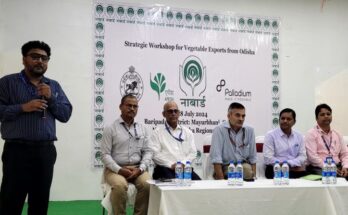Sugar mills body, Indian Sugar Mills Association (ISMA) has lowered its nation-wide sugar production estimate for 2018-18 sugar season from 350 lakh tonnes to 315 lakh tonnes. The sugar mills body has given many reasons ranging from adverse weather impact to grub infestation.
According to ISMA, sugar production for the season is being reported to be lower than what was estimated in July 2018. The crop in the three main sugarcane growing states, namely, Uttar Pradesh, Maharashtra and Karnataka which contribute for around 80 percent of country’s sugar production, have all been adversely impacted due to various reasons, Indian Sugar Mills Association (ISMA) has said.
Uttar Pradesh
The sugarcane area in UP for this season is seen to be slightly higher than the area under sugarcane in 2017-18 SS. The area under the high yielding variety Co0238 is also higher and, therefore, it was expected that sugarcane and sugar production in 2018-19 sugar season, as compared to last year, would be around 10-15 lakh tonnes more.
However, several areas in UP have had untimely rainfall in September 2018 which has adversely affected the growth of the sugarcane at this very important maturity period. Further, some areas have reported water-logging and in some parts of western UP, there has been sugarcane lodging also.
Due to the above reasons, the sugarcane yields will be significantly lower than what was estimated earlier and also lower than what was achieved in the previous sugar season. At the same time, the sugar recovery will also get adversely impacted. Accordingly, ISMA has revised its sugar production estimates for UP from 130-135 lakh tonnes made in July 2018 to 121 lakh tonnes. This is almost similar to 120.45 lakh tonnes produced by UP sugar mills in the previous sugar season.
Maharashtra
The area under sugarcane in Maharashtra as per the satellite images taken in June 2018 were around 25 percent more than the acreage in 2017-18 SS. Accordingly, ISMA had estimated a sugar production of around 110-115 lakh tonnes in 2018-19 SS, slightly higher to the actual sugar production of 107.23 lakh tonnes last season.
The yields which were around 108 tonnes per hectare in the last year were expected to drop to around 90 tonnes per hectare because of larger proportion of ratoon crop in the overall mix.
These estimates were made considering a normal rainfall during July – September 2018 which has a big influence on the sugarcane yields and sugar recovery. However, during the last 2-3 months, the rainfall in most of the sugarcane areas in Maharashtra has been substantially lower than last year same period as well as below normal average of the last three years.
In addition to the above, white grub has infested a significant area in the districts of Ahmednagar, Solapur and Marathwada and to a lesser extent in Kolhapur, Sangli, Satara and Pune. In some small areas within the above mentioned districts, the crop has been so seriously infested that either the farmers have uprooted them or the crop has not survived. Due to the impact of the lower rainfall and the white grub infestation, the sugarcane yield in Maharashtra is expected to be lower by almost 16-18 percent as compared to what was estimated 3-4 months ago.
Further, the sugar recovery is also expected to be not only lower to what was expected earlier, but even slightly lower over the last season. Therefore, despite substantial increase in acreage in Maharashtra, the sugar production now estimated from Maharashtra will be much lower than last year. As compared to the production of 107.23 lakh tonnes in 2017-18 SS, the sugar production expected from Maharashtra in the current 2018-19 SS is around 95 lakh tonnes.
Karnataka
The northern part of Karnataka being contiguous to sugarcane grown in southern part of Maharashtra, have also suffered due to lower rainfall as well as some infestation of white grub. The impact is, however, lower than Maharashtra. Even though the sugarcane acreage is about 20 percent more in Karnataka as compared to the last sugar season, the sugar production now estimated from Karnataka is expected to be only around 12-13 percent higher than last season. The sugar production estimation has accordingly been reduced by ISMA for Karnataka from 44.8 lakh tonnes estimated in July 2018 to around 42 lakh tonnes now.
There has not been any major changes in the other sugarcane growing states of the country. The rainfall therein has been more or less as expected.
Considering the adverse impact of weather and rainfall in the three largest sugarcane producing states of UP, Maharashtra and Karnataka and white grub infestation in Maharashtra and North Karnataka. Sugar production in 2018-19 SS would be around 320 lakh tonnes. However, this figure may be lower if we consider the expected diversion of sugar to ethanol.
The tender for ethanol procurement for 2018-19 SS has been opened by the oil marketing companies (OMCs), and for the first time there has been a bid for 48.5 crore litres of ethanol from ‘B’ heavy molasses and 1.84 crore litres from sugarcane juice. Expecting that almost all of these will be contracted for and produced by the sugar mills in the distilleries, there will be a further reduction in sugar production because of the above diversion of ‘B’ heavy molasses and sugarcane juice away from sugar into ethanol. As per standards, this would mean a diversion of around 4.5 to 5 lakh tonnes of sugar into ethanol. Therefore, the sugar production estimates for 2018-19, after considering this diversion into ethanol, will be around 315 lakh tonnes of sugar.
The sugarcane crushing has not yet started in most of the areas and, therefore, a better picture would emerge once the crushing starts and actual trend of yields and sugar recoveries would become available. As has been the practice, ISMA will once again revisit the sugarcane and sugar production in January 2019 when the trends of the above are available.
Considering that the opening balance was 107 lakh tonnes as on October 1, 2018 and an expected domestic consumption of around 255-260 lakh tonnes and if the industry is able to export 40-50 lakh tonnes during the season, the closing balance as on September 30, 2019 would be around 112-127 lac tonnes. This would again a very high opening balance as on October 1, 2019, compared to country’s requirement equivalent to two months consumption.
ISMA lowers 2018-19 sugar production estimate




